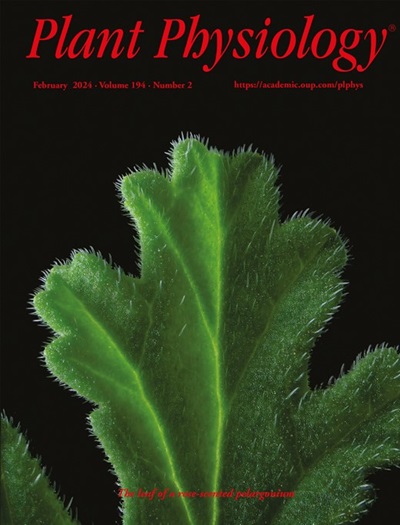在干旱期间,维管植物谱系的不同途径导致夜间蒸腾作用减少。
IF 6.9
1区 生物学
Q1 PLANT SCIENCES
引用次数: 0
摘要
水分亏缺时的气孔关闭对维持植物水分平衡至关重要。虽然在干旱条件下驱动白天气孔关闭的机制已经得到了很好的研究,但在干旱条件下驱动夜间蒸腾(Enight)逐渐下降的机制仍然知之甚少。为了研究脱落酸(ABA)或叶片水分状态下降是否会导致维管植物干旱期间夜间蒸腾作用的逐渐下降,我们对具有代表性的蕨类植物、裸子植物和被子植物进行了实验,包括一个严重ABA缺乏的突变体和树种。从蕨类植物对内源ABA不敏感到草本被子植物依赖ABA关闭气孔,这些物种的气孔受ABA控制的范围很广。我们发现,干旱期间,蕨类植物和裸子植物的Enight减少是由水被动的气孔关闭驱动的,在严重胁迫下裸子植物向ABA调节过渡,草本被子植物的ABA触发了Enight的减少。在所有物种中,由于干旱期间气孔关闭,夜间发生的总蒸腾比例增加。干旱期间夜间蒸腾的减少似乎是维管陆地植物的一种收敛的气孔响应,但受与进化历史和生态策略相关的多种调节机制的驱动。本文章由计算机程序翻译,如有差异,请以英文原文为准。
Divergent pathways across vascular plant lineages drive reduced nighttime transpiration during drought.
Stomatal closure in response to water deficit is crucial for maintaining plant water balance. While the mechanisms driving daytime stomatal closure under drought are well studied, the mechanism driving progressive declines in nighttime transpiration (Enight) during drought remains less understood. To investigate whether either abscisic acid (ABA) or declining leaf water status drives progressive declines in nighttime transpiration during drought in vascular plants, we conducted experiments using representative fern, gymnosperm, and angiosperm species, including a severe ABA-deficient mutant and tree species. These species span a spectrum of stomatal control by ABA, ranging from insensitive to endogenous ABA in the fern to reliance on ABA for stomatal closure in the herbaceous angiosperm. We found that reductions in Enight during drought are driven by hydropassive stomatal closure in ferns and gymnosperms, transitioning to ABA regulation in gymnosperms under severe stress, and are triggered by ABA in herbaceous angiosperms. In all species, the proportion of total transpiration occurring at night increased as stomata closed during the drought. The reduction of nighttime transpiration during drought appears to be a convergent stomatal response across vascular land plants but is driven by diverse regulatory mechanisms linked to evolutionary history and ecological strategy.
求助全文
通过发布文献求助,成功后即可免费获取论文全文。
去求助
来源期刊

Plant Physiology
生物-植物科学
CiteScore
12.20
自引率
5.40%
发文量
535
审稿时长
2.3 months
期刊介绍:
Plant Physiology® is a distinguished and highly respected journal with a rich history dating back to its establishment in 1926. It stands as a leading international publication in the field of plant biology, covering a comprehensive range of topics from the molecular and structural aspects of plant life to systems biology and ecophysiology. Recognized as the most highly cited journal in plant sciences, Plant Physiology® is a testament to its commitment to excellence and the dissemination of groundbreaking research.
As the official publication of the American Society of Plant Biologists, Plant Physiology® upholds rigorous peer-review standards, ensuring that the scientific community receives the highest quality research. The journal releases 12 issues annually, providing a steady stream of new findings and insights to its readership.
 求助内容:
求助内容: 应助结果提醒方式:
应助结果提醒方式:


